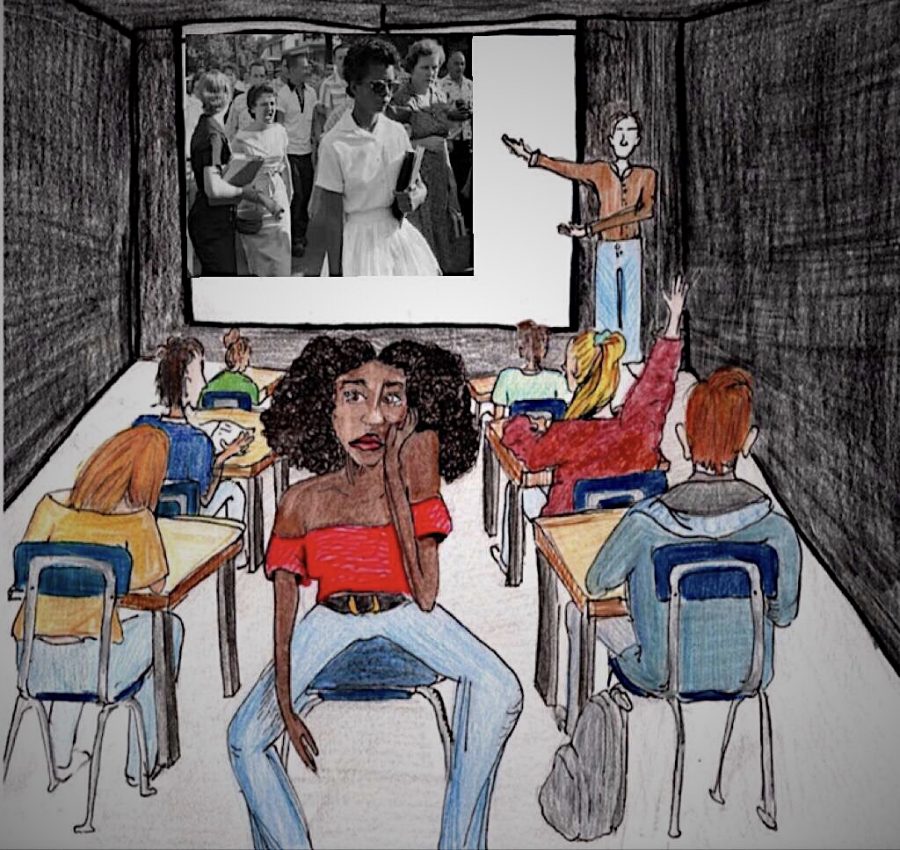How do I break the wall with my bare hands?
December 26, 2018
A five-part, comprehensive look into academic reparations at ETHS
It shines on the screen.
As the discussion of desegregation surfaces within the curriculum once again, the all-too-familiar image of Little Rock Nine member Elizabeth Eckford walking to school with mobs of Southern whites assailing her dimly gleams onto the apathetic faces of 20 or so students—all while the teacher desperately implores reflection, only to be met with surface-level shame and pity.
Naturally, the apathy returns and as does the students’ fatigue of talking about the same topic they’ve learned since fourth grade. However, amidst this emotional numbness, pride begins to linger in the air, both feelings stemming from the bold thought that we’ve come so far.
Following the daily battles of Little Rock Nine in the 50s, poodle skirts and sock hops faded with the times, and racism—at least overt racism—followed slowly in their path. Thus, the calls for reparations and progress spread across the country like wildfire, hardly wavering at all, not even against the tempestuous pushback of a bigotted America, whose ignorant unwillingness refused to go quietly against the dying of the white.
The objections proved futile as reparations were eventually met, at least enough so to alleviate the headache that is white guilt. However, these reparations were not of the acre and mule variety. In fact, they challenged the old notion of reparations entirely. Instead of providing economic reparations as they did after the Reconstruction era following the Civil War, these reparations focused on the social advancement of historically oppressed people.
In 1965, President Lyndon B. Johnson issued an executive order—one that promised for the creation of non-discriminatory practices and equal opportunity to historically oppressed peoples—and introduced what we know today as Affirmative Action. With its initial purpose of fostering more equitable hiring practices and bringing more diversity to the workplace, Affirmative Action began to filter into the classroom.
However, Affirmative Action does not come without controversy. In an ongoing Supreme Court case, with the help of conservative activist and opponent of racial consideration in voting rights, a group of Asian-American students filed claims against Harvard’s admission process, asserting that the process had been intentionally discriminatory against Asian-Americans in favor of other students of color. This is far from the only inquest of Affirmative Action’s possible negative impact on students of color.
Especially in Evanston, a town with a history abundantly riddled with failures in desegregation, academic reparations have been intrinsically tied to the town’s attempts to bring more equality to the community. ETHS has even implicitly utilized various models of Affirmative Action within its classrooms, clubs and communities as a means of fostering its natural diversity.
In my lived experience, not only as a student but a student of color, I have observed ETHS’s reliance on three specific models of Affirmative Action: quota, outreach and preference, and all of these models come with their respective issues.
With quota systems comes the issue of tokenism, which dehumanizes students of color as visible images of diversity. With outreach comes the issue of invalidation, which others the viewpoints of students of color as separate from the white majority. With preference comes the issue of subversion of POC solidarity, which unfairly determines who is a POC and who is not. At each turn, Affirmative Action failed utterly, and what once aimed to grant equal opportunities to students of color became nefarious.
Beyond its icy reception from a less-than-happy white America, who often likes to decry its supposed roots in reverse racism, Affirmative Action could have never successfully provided academic reparations to students of color because it has never considered its implications. Without thinking through these implications, Affirmative Action has only ever served one group of people in the United States: white people, whose long-standing, four centuries-long harboring of guilt has slowly eaten away at them.
While it is true that Affirmative Action has brought more harm than good, this isn’t to say that it is a complete lost cause. Despite Affirmative Action and the failed use of its various models at ETHS, academic reparations—true reparations—must be carried out to the fullest extent.
Academic reparations are essential to the success of students of color because as time wore on, the ravenous mobs of Southern whites became figurative. Racism never disappeared, rather, it merely took off its white hood to don a new guise, one that would fight all of its battles with a duplicitous grin, all the while wreaking havoc within one of America’s most trusted institutions: its education system.
Every single day, students of color do not just attend school. Every single day, students of color must gear up to face the nasty opposition of America’s school system, one that is reliant and insistent on their failure. The American school system has created a wall between students of color and success, to the point where no matter how tirelessly these students try to work, their efforts are never awarded to the extent that their white peers are. Every single day, students of color must continue to beat against this wall until their knuckles become sore. They become entirely resigned to the fate that the American school system has set forth for them, a fate that means certain failure at every turn.
The perfect solution to academic reparations cannot be made for the sole purpose of making white people feel better about themselves. All valuable equity work should not be made to serve the assuaging of white guilt. The perfect solution to academic reparations must be made with the success of students of color as its sole purpose.
Without academic reparations, students of color will have to break the wall with their bare hands, beating ceaselessly as every bone in their hand cracks, every piece of skin peels and every blood vessel explodes. Soon, they will find that breaking the wall with their bare hands was never meant to be achievable; it was meant to be heartbreaking. It was meant to be entertaining to a white authority, one that could sit above in their envelope of privilege, watching as the blood of the students painted the wall with brilliant hues of red as well as browning hues of despair.
How do I break the wall with my bare hands? The answer is I don’t.
The winding path to finding the perfect solution begins with evaluating the shortcomings of the current solution to academic reparations. In a critical assessment of the practice of Evanston’s three main models of Affirmative Action along with their corresponding repercussions, I will be searching for the correct way to achieve academic reparations. Each separate evaluation of a different model of Affirmative Action will be released bi-weekly on evanstonian.net.










